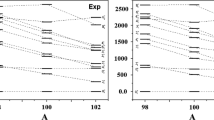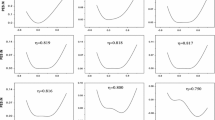Abstract
Using interacting boson model, shape phase transitions from U(5) to O(6) and from U(5) to SU(3) are studied in the space of two control parameters. Some simple shape phase diagrams in terms of the order parameter and one of the control parameters are presented. Spectra and E2 transition rates are used to construct observables. It is shown that these observables exhibit the behavior of the shape phase transition, namely a peak structure at and after the critical point.
Similar content being viewed by others
References
Rowe D J, Bahri C, Wijesundera W. Exactly solvable model of a superconducting to rotational phase transition. Phys Rev Lett, 1998, 80: 4394–4397
Iachello F, Zamfir N V, Casten R F. Phase coexistence in transitional nuclei and the interacting model. Phys Rev Lett, 1998, 81: 1191–1194
Casten R F, Kusnezov D, Zamfir N V. Phase transitions in finite nuclei and the integer nucleon number problem. Phys Rev Lett, 1999, 82: 5000–5003
Rowe D J. Quasidynamical symmetry in an interacting boson model phase transition. Phys Rev Lett, 2004, 93: 122502-1-4
Iachello F, Arima A. The Interacting Boson Model. Cambridge: Cambridge University Press, 1987
Iachello F, Levine R D. Algebraic Theory of Molecules. Oxford: Oxford University Press, 1987
Bijker R, Iachello F, Leviatan A. Algebraic models of hadron structure (I): Nonstrange baryons, Ann Phys (N. Y.), 1994, 236: 69–116
Zhang J F, Pak J Y, Liu F Y. Low-lying spectra and E2 transition rates in even-even Ce isotopes in the interacting boson model. HEP & NP (in Chinese), 2000, 24(11): 1066–1072
Liu F Y, Zhang J F, Pak J Y. Low-lying spectra and E2 transition rates in even-even Pd isotopes in the interacting boson model. Chin Phys, 2001, 10: 194–201
Zhang J F, AL-Khudair H F, Long G L, et al. Mixed symmetry states in the even-even 96-106Mo nuclei. Commun Theor Phys, 2002, 37: 335–340
Iachello F. Dynamic symmetries at the critical point. Phys Rev Lett, 2000, 85: 3580–3583
Iachello F. Analytic description of critical point nuclei in a_spherical-axially deformed shape phase transition. Phys Rev Lett, 2001, 87: 052502-1-4
Iachello F. Phase transitions in angle variables. Phys Rev Lett, 2003, 91: 132502-1-4
Bonatsos D, Lenisa D, Petrellis D, et al. Z(5): critical point symmetry for the prolate to oblate nuclear shape phase transition. Phys Lett, 2004, B 588: 172–177
Cejnar P, Jolie J. Quantum phase transitions studied within the interacting boson model. Phys Rev, 2000, E61: 6237–6247
García-Ramos J E, De Coster C, Fossion R, et al. Two-neutron separation energies, binding energies and phase transitions in the interacting model. Nucl Phys, 2001, A688: 735–754
Arias J M, Dukelsky J J, García-Ramos E. Quantum phase transitions in the interacting model: integrability, level repulsion, and level crossing. Phys Rev Lett, 2003, 91:m162502-1–4
Pan F, Draayer J P, Luo Y A. A close look at U(5)-SU(3) transitional patterns in the interacting boson model. Phys Lett, 2003, B 576: 297–302
Caprio M A, Iachello F. Phase structure of the two-fluid proton-neutron system. Phys Rev Lett, 2004, 93: 242501-1–4
Rowe D J, Turner P S. Scaling properties and asymptotic spectra of finite models of phase transitions as they approach macroscopic limits. Phys Rev Lett, 2004, 93: 232502-1–4
Agrawal B K, Sil T, De J N, et al. Nuclear shape transition at finite temperature in a relativistic mean field approach. Phys Rev, 2000, C62: 044307-1–8
Liu Y X, Mu L Z, Wei H Q. Approach to the rotation driven vibrational to axially rotational shape phase transition along the yrast line of a nucleus. Phys Lett, 2006, B 633: 49–53
Mu L Z, Liu Y X. Rotation driven shape-phase transition of the yrast nuclear states with O(6) symmetry in the interacting boson model. Chin Phys Lett, 2005, 22: 1354–1357
Werner V, Von Brentano P, Casten R F, et al. Singular character of critical points in nuclei. Phys Lett, 2002, B 527: 55–61
Stachel J, Isacker P V, Heyde K. Interpretation of the A ∼ 100 transitional region in the framework of the interacting boson model. Phys Rev, 1982, C 25: 650–657
Author information
Authors and Affiliations
Corresponding author
Additional information
Supported in part by the National Natural Science Foundation of China (Grant Nos. 10265001 and 10547003), Inner Mongolian Natural Science Foundation (Grant No. 200607010111), and the Key Scientific Research Fund of Inner Mongolian Educational Bureau (Grant No. NJ05007)
About this article
Cite this article
JinFu, Z., HongBo, B. Some observables as an indication of atomic nuclear shape phase transition. CHINESE SCI BULL 52, 165–170 (2007). https://doi.org/10.1007/s11434-007-0016-4
Received:
Accepted:
Issue Date:
DOI: https://doi.org/10.1007/s11434-007-0016-4




